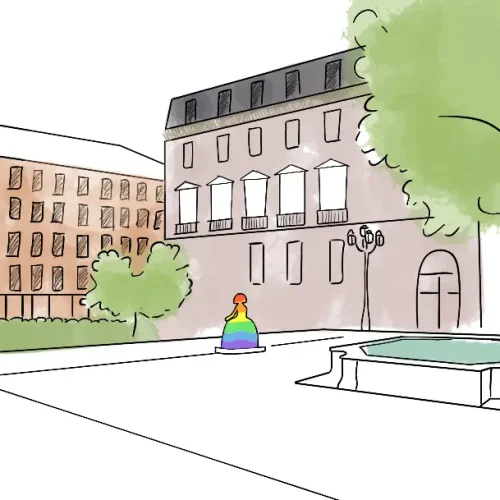Chueca Diversa. The Neighborhood of Diversity
Its name alone evokes freedom and welcome. Chueca is much more than a neighborhood, it is a reference point for the LGTBI+ movement worldwide. Here began a trend towards visibility that is now unstoppable, a way of life based on respect.
A few decades ago, bars, restaurants and different businesses, such as bookstores and fashion stores, specialized in the LGBT+ world began to set up in the area. Among them, some are already a symbol, such as the Berkana bookstore, or the Black & White entertainment venue, among others. Their presence, at first, surprised the long-time neighbors, who have been privileged witnesses of the transformation of their neighborhood into an epicenter of tolerance and modernity. A place where they enjoy a lifestyle free of prejudice and exclusion. The neighborhood is one of the most cosmopolitan and vibrant areas of Madrid. The Plaza de Chueca is its nerve center. Also, the Pedro Zerolo square, which since 2015 bears the name of one of the activists who worked hardest in defense of the rights of the LGTBI+ community in Spain.
Avant-garde art galleries, trendy fashion stores such as Rubén Galarreta, international cuisine restaurants such as Angelita Madrid or Diurno, markets like San Antón where gastronomy is mixed with commerce and lively terraces flood every street and corner, with a hectic life, day and night. Because the night here boasts of being one of the most fun.
The surrounding areas merge their energy and vitality with the neighborhood of Chueca and offer visitors a wide and diverse offer difficult to match. This is the case of Calle Fuencarral, the undisputed protagonist of shopping in Madrid, Malasaña, where the most emerging creators meet, and Salesas, one of the capital’s elegant neighborhoods.
DISCOVER DIVERSE CHUECA
Places of Interest
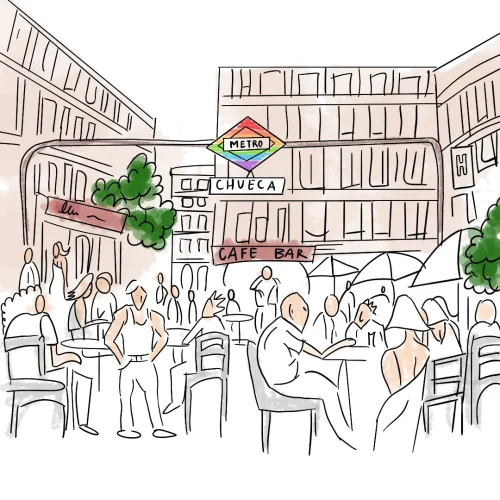
Chueca Square
The Plaza de Chueca is the nerve center of the Chueca neighborhood, which since 1943 has paid tribute to the Madrid composer Federico Chueca.
The square is full of terraces when the weather is good and around it revolves the life of the neighborhood. We can find the centenary Bodega Angel Sierra, a bar that retains intact all its charm of 1900 and where you can take the vermouth of Reus. The barEscape is a legendary establishment in the neighborhood aimed especially at the lesbian public or the Chuequita are some of the bars and terraces that together with other locals make this square a meeting point, leisure and shopping.
This square is the heart of the LGTB neighborhood of Madrid; but why does Chueca bring together the restaurants, bars and the atmosphere of the collective? Even after Franco’s dictatorship, and with the transition to democracy behind us, Chueca was still a marginal and unsafe neighborhood. With the passage of time, Chueca was leaving aside the dark bars and the rainbow flags were flooding the stores, the balconies, the bars, the bookstores?
In general, a new, modern and rejuvenating air had arrived to stay in a neighborhood that nobody wanted to live in before. In short, LGTB people were relegated to a marginal neighborhood, which was the only place where they were allowed to be; thus, the people of the collective changed the neighborhood, gave it a new life, and made Chueca what it is now: a historical landmark representing the LGTB struggle.
Pedro Zerolo Square
Pedro Zerolo Square, in honor of the politician Pedro Zerolo, one of the most important and recognized activists in the LGTBI+ struggle in Spain, was one of the promoters of the same-sex marriage law, approved on July 3, 2005, as well as responsible for the sexual identity law that recognized the right of transgender people.
In it, every year the famous LGTBI Pride proclamation takes place. Among the terraces surrounding the square, there are different establishments that form a fun mosaic where you can have an aperitif or lunch and dinner.
The square’s parking lot features a large red ribbon (symbol of the fight against HIV) at the entrance, designed by architect Teresa Sapey, and its colorful interior includes quotes from Dante’s Divine Comedy .
This well-known square is one of the epicenters of the Chueca neighborhood and it is where most of the activities that take place during the Gay Pride festivities take place; among them, the opening speech. In 2015, the Plenary of the Madrid City Council approved to change the name of the square to “Plaza de Pedro Zerolo”, in tribute to the PSOE councilman and activist for LGBT rights. Pedro Zerolo is considered one of the most important LGBT activists in the history of Spain, as well as one of the greatest promoters of the extension of the right to marriage and adoption for homosexual couples in the country.
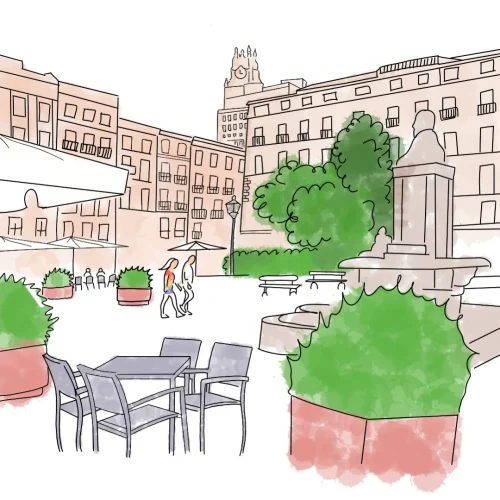
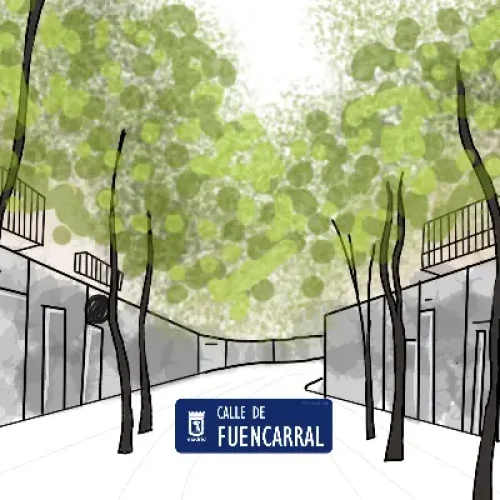
Fuencarral Street
Fuencarral Street is one of the most modern streets of Madrid, here many of the most cutting-edge and avant-garde fashion stores of the moment meet and at any time of the day it is full of vitality.
It is the central axis of a large shopping area that stretches from Malasaña to Chueca and began to emerge in the late nineties around the Fuencarral Market, a space of culture, fashion and alternative and independent style, which closed its doors in 2015 and where the Decathlon sports store is currently located.
Currently, through it, we find stores of some of the major fashion brands such as Mango, Cos, Pepe Jeans, Diesel, Antony Morato, Guess, Kiehl’s, Lush, El Ganso, Levis or Calvin Klein. Its avant-garde and colorful shop windows show tattoo and piercing stores, shoes, perfumes, fashion and accessories. You will also find the San Ildefonso Market where you can taste and enjoy gastronomy at its best.
Fuencarral street joins Gran Vía street with Chamberí neighborhood through a long stretch that is considered one of the most bustling points of Madrid, since it concentrates a multitude of stores and restaurants. In its surroundings we find many vintage clothing stores where they are mixed with the latest trends, classic cafes or markets that coexist with cultural spaces such as the Telefonica Foundation Space or the Museum of History. As if that were not enough, it is one of the most frequented areas in Madrid’s nightlife, with a multitude of pubs and bars.
Hortaleza Street
Hortaleza street is the main entrance to the neighborhood of Chueca. The famous La Kama Café, the pioneer bookstore Berkana, the drag show Vuélvete Loca by Chumina Power or the legendary restaurant Vivares and fashion stores make this street never sleeps. We can also find the headquarters of the Official College of Architects of Madrid (COAM).
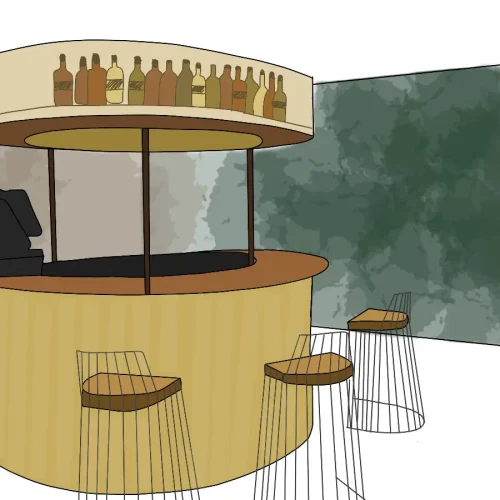
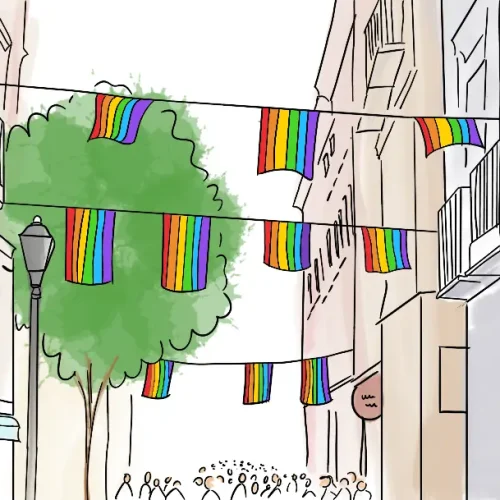
Pelayo Street
Pelayo Street is the nerve center of Chueca’s nightlife. It is a meeting point for all LGTBI people in the capital, and serves as a place of celebration on many occasions.
It is one of the main streets in the neighborhood during the celebration of Madrid Pride, where every year the popular heel race takes place.
Throughout the year, this important street in the Chueca neighborhood is very busy for those looking for special experiences: from a decoration store, fashion, specialized bookstores, art or gastronomy, to beauty salons and hairdressers.
On the corner with Fernando VI we can highlight the SGAE building, emblematic for its modernist construction, the Mad is Mad art gallery, the Dlirio Live cocktail bar, the A different Life and Nakama Lib bookstores, the mythical LL Bar, the González&González and Aunty B decoration stores or dinner at the Señor.Ito restaurant.
Diverse Chueca
Company directory
Discover our LGTBIQ+ Business Guide
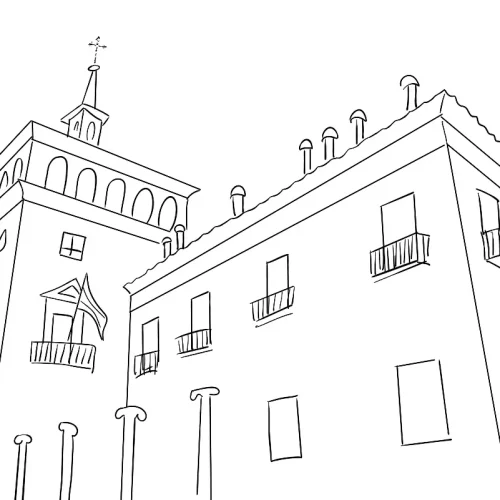
House of the 7 chimneys
Located in Plaza del Rey, it is one of the few remaining examples of 16th century civil architecture in Madrid. The house of the 7 chimneys is a mansion with two floors and a hipped roof topped by seven chimneys. From these chimneys comes the name of the house and also, around them, has been originating a series of legends such as, for example, which says that the seven chimneys represent the seven deadly sins or that the house served as a prison for an illegitimate daughter of Philip II and that his spirit still lives there. On the other hand, has been the scene and witness of exception of popular uprisings such as the Mutiny of Esquilache in the eighteenth century to the origin of the feminist movement in Spain as the headquarters of the Lyceum Club Femenino in the 30’s. It has also been home to several banks, including noble residence; currently, it is one of the headquarters of the Ministry of Education and Culture, being declared in 1995 of Cultural Interest.
Museum of Romanticism
The former palace of the Marquis of Matallana, built in 1776, houses an interesting collection of paintings, furniture and decorative arts of the nineteenth century, which recreates the daily life and customs of the gentry during Romanticism. During the visit, the public can learn what society was like during this historical period, as well as who were the main protagonists of this cultural movement in Spain. Inside, we can find works by Goya, Esquivel, Madrazo…
13 San Mateo Street
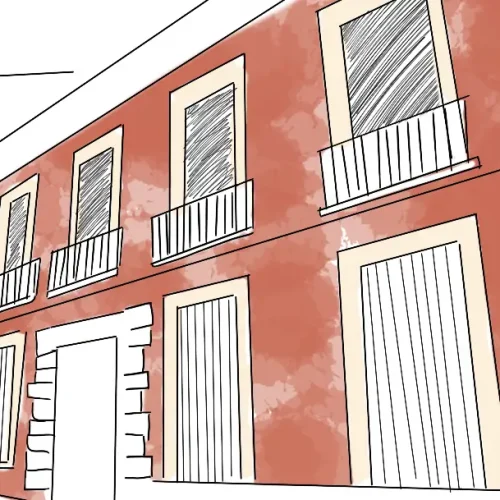

San Antón Church
Also known as the Real Iglesia de San Antón or Real Iglesia de las Escuelas Pías de San Antón, it is a baroque temple that commemorates the popular festival of San Antón, in which pets are blessed. Managed since 2015 by Mensajeros de la Paz, the church has an extensive program of social and religious activities, as well as services to help those most in need.
Calle de Hortaleza, 63
SGAE Building
The headquarters of the Sociedad General de Autores (SGAE) is known for being one of the few purely modernist buildings in Madrid; in fact, this emblematic building is famous for its luxurious and ornate exterior. The SGAE is an institution whose function is to defend the author and publisher by managing the rights of reproduction, distribution and public communication of literary, musical, theatrical, cinematographic and audiovisual works.
Fernando VI Street, 4
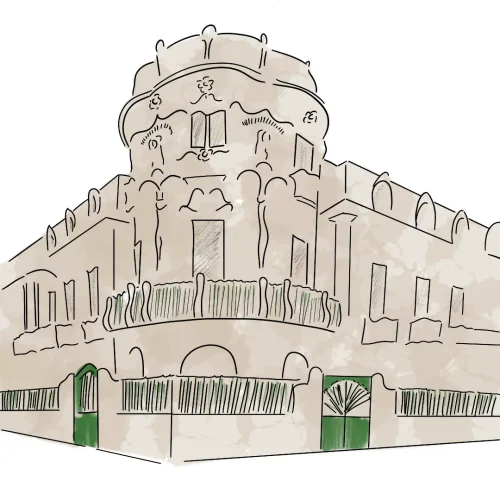
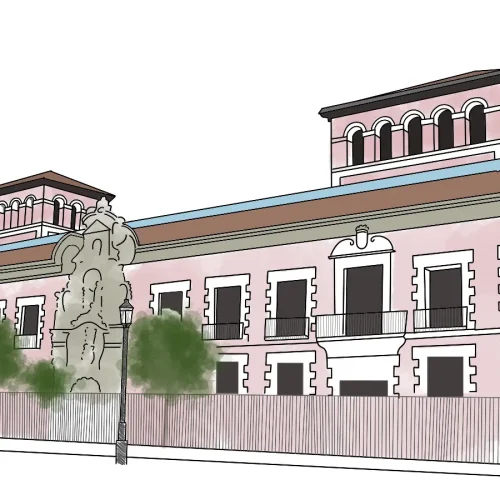
Madrid History Museum
Former hospice of San Fernando, this museum exhibits one of the best examples of the historical evolution of Madrid and offers an overview of the arts, industries, daily life and customs of its inhabitants since it was elected capital of Spain in 1561 to the present day. At present, it brings together 60,000 objects of various kinds related to Madrid; it even has a chapel inside, where concerts and conferences are held.
78 Fuencarral Street
King's Square
This square, located in the heart of the Chueca neighborhood, is named in honor of the proclamation by the people of Madrid in 1808 to Ferdinand VII as king of Spain. In the middle of the square, a statue is erected in honor of Lieutenant Jacinto Ruiz y Mendoza, one of the leaders of the resistance during the uprising of May 2, 1808 in Madrid.
King’s Square
